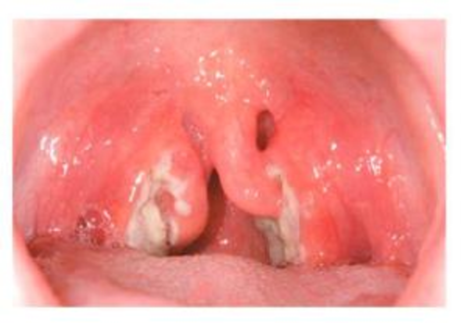
The Big Game

College sophomore Nadia is a star point guard for her school’s basketball team. She is excited about the divisional finals Friday night-she’s even heard rumors that a professional scout will be in the stands. On Thursday morning, she wakes up with a sore throa1. Her forehead doesn’t feel warm, so she forces herself to attend her Thursday classes; but when she wakes up on Friday morning, her throat is noticeably worse. Still, she forces herself to attend Friday morning class but feels tired and much worse by noon. It is downright painful to swallow, and she skips lunch.
Nearly crying, she heads back to the dorm and checks her temperature—101°F. Desperate, she walks to the student health center, where a nurse practitioner notices white spots on the back of Nadia's throat and on her tonsils. The divisional basketball game starts in six hours, but it only takes a few minutes for the nurse practitioner to perform a rapid streptococcal antigen test and determine that Nadia has streptococcal pharyngitis—strep throat. She will miss the big game.
Strep throat is caused by an encapsulated, Gram-positive bacterium, Streptococcus pyogenes. The only good news is that by taking the prescribed penicillin, Nadia should be ready for her next big game-hopefully, the quarterfinals.
- 1. How does the capsule of Streptococcus contribute to the bacterium's ability to cause disease?
- 2. What bacterial structures, besides the capsule, may be allowing Streptococcus to infect Nadia’s throat?
- 3. Penicillin works by interrupting the formation of peptidoglycan. What bacterial structure contains peptidoglycan? In a Gram-positive organism such as Streptococcus, is this structure typically thicker or thinner than ii would be in a Gram-negative bacterium?
Want to see the full answer?
Check out a sample textbook solution
Chapter 3 Solutions
EP MICROBIOLOGY:W/DISEASES BY..-MOD.ACC
- Plating 50 microliters of a sample diluted by a factor of 10-6 produced 91 colonies. What was the originalcell density (CFU/ml) in the sample?arrow_forwardEvery tutor here has got this wrong, don't copy off them.arrow_forwardSuppose that the population from question #1 (data is in table below) is experiencing inbreeding depression (F=.25) (and no longer experiencing natural selection). Calculate the new expected genotype frequencies (f) in this population after one round of inbreeding. Please round to 3 decimal places. Genotype Adh Adh Number of Flies 595 Adh Adh 310 Adhs Adhs 95 Total 1000 fladh Adh- flAdn Adh fAdhs Adharrow_forward
- Which of the following best describes why it is difficult to develop antiviral drugs? Explain why. A. antiviral drugs are very difficult to develop andhave no side effects B. viruses are difficult to target because they usethe host cell’s enzymes and ribosomes tometabolize and replicate C. viruses are too small to be targeted by drugs D. viral infections usually clear up on their ownwith no problemsarrow_forwardThis question has 3 parts (A, B, & C), and is under the subject of Nutrition. Thank you!arrow_forwardThey got this question wrong the 2 previous times I uploaded it here, please make sure it's correvct this time.arrow_forward
- This question has multiple parts (A, B & C), and under the subject of Nutrition. Thank you!arrow_forwardCalculate the CFU/ml of a urine sample if 138 E. coli colonies were counted on a Nutrient Agar Plate when0.5 mls were plated on the NA plate from a 10-9 dilution tube. You must highlight and express your answerin scientific notatioarrow_forwardDon't copy off the other answer if there is anyarrow_forward
 Human Biology (MindTap Course List)BiologyISBN:9781305112100Author:Cecie Starr, Beverly McMillanPublisher:Cengage Learning
Human Biology (MindTap Course List)BiologyISBN:9781305112100Author:Cecie Starr, Beverly McMillanPublisher:Cengage Learning Human Physiology: From Cells to Systems (MindTap ...BiologyISBN:9781285866932Author:Lauralee SherwoodPublisher:Cengage LearningUnderstanding Health Insurance: A Guide to Billin...Health & NutritionISBN:9781337679480Author:GREENPublisher:Cengage
Human Physiology: From Cells to Systems (MindTap ...BiologyISBN:9781285866932Author:Lauralee SherwoodPublisher:Cengage LearningUnderstanding Health Insurance: A Guide to Billin...Health & NutritionISBN:9781337679480Author:GREENPublisher:Cengage





